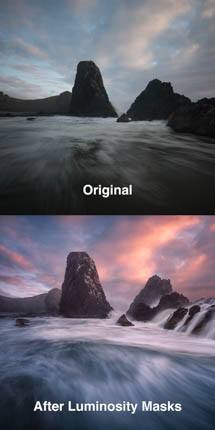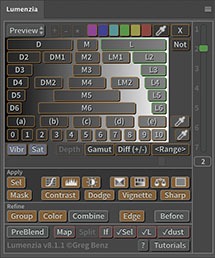I recently received an email from Jim Kay, who asked me how he might go about using Lumenzia to help isolate the bird in this image in order to darken the background. He’s done a wonderful job using a 500m lens to help remove distractions, but the background is still very bright and keeps the main subject from standing out as much as it he’d like. An ideal solution is to mask the bird to allow non-destructive darkening of the background.
Unfortunately, this is a very tricky task because the bird and branch are extremely similar in tone and color of the background. This limits my preferred solution, which would be to create a luminosity selection and let the image itself help create a perfect mask. The best approach here is to create a crude selection and refine the edges for a clean transition from subject to background.
There are several ways to create a crude selection, and each has its own advantages:
- The Quick Select tool, which allows you to click and drag to identify the subject, with Photoshop automatically seeking appropriate edges. This is generally one of my favorite tools for making crude selections. To use it to its full potential, use both the additive and subtract modes to refine the selection – do not expect perfection with a single click of this tool. Make sure “enhance edge” is checked.
- Image / Select Subject, which attempts to isolate humans and animals. In this case, it does a great job selecting the bird (other than its feet), though it ignores the branch.
- The new Object Selection tool, which uses artificial intelligence to help select a subject from a rectangular or lasso selection input from the user. I tried this as well and felt took more time with this image.
- The Magnetic Lasso tool. This is a lasso tool which attempts to snap to the edges of a selection. It can work well with high contrast edges when working zoomed in with appropriate settings for width and contrast. However, I find that other tools tend to work more easily on such images and this is an option I don’t use often.
- Select / Color Range. Unfortunately, when luminosity masks aren’t an option, this approach often fails for the same reason that the color and luminosity of the subject and background are too similar. I generally find this tool less precise than using customized luminosity masks for cutouts and tend to reserve it for other use cases. But if you aren’t using a panel to help create advanced luminosity selections, this is a great option.
Once you have the rough selection, there are several options to refine the edges:
- The Select and Mask workspace (aka Refine Edge in older versions of Photoshop).
- The edge detection radius helps automatically clean up edges. This is a global setting for all detected edges. It isn’t perfect, but can often do a great job. Adding a very slight feather (around 0.3 pixels) can also help.
- The Refine Edge Brush Tool is a handy way to locally target edges. This is best used when the ideal refine radius varies around the image, such as for using painting a large radius over hair without affecting the rest the subject by increasing the radius globally.
- The standard Brush tool can be used to manually paint in missing ares. Unfortunately, if you activate the standard brush tool and start to paint, the edge detection radius will reset to 0 (which I consider a bug in the interface). So be sure to check and reset that radius if you use the brush.
- The Quick Select tool can help add missing areas quickly. Try turning on a red overlay and checking the option to show edges, which will help make it very clear when you have properly targeted the edges while working with this tool. Be sure to take advantage of the subtracted mode by holding <alt/option> to cleanup with with tool.
- Th Object Selection tool is also available in newer versions of Photoshop CC and tends to be very useful when used in the lasso mode.
- The standard Lasso tool is an option and is most useful in the subtract or intersection modes to help remove unwanted areas of the selection.
- Painting through Luminosity selections. Even if the main subject cannot be isolated with a luminosity selection, these can often be helpful to refine particular edges of the cutout. Because the pixel color and luminosity is nearly or truly identical to the background, they aren’t useful for a lot of edges in this image.
- The dodge and burn tools in Photoshop (these are available with ideal settings via the — and +++ buttons in the Lumenzia Basics panel). These are a great way to help nudge grey pixels in the mask towards white or black, and are a good way to do secondary cleanup if needed after using Select and Mask or luminosity selections.
- Painting with a white or black brush in soft light or overlay blend mode is another popular option to help nudge grey pixels towards black or white. However, I find that the dodge and burn brushes not only provide a better result in most cases, they are also much easier to select that continuously changing the blend mode for the brush.
- Manually painting with a standard brush. Sometimes the best fix for small areas is to paint by hand, and it’s often quick to make a few enhancements this way. This is most commonly needed when the subject and background have similar colors and tones, which causes problems for many of the tools above.
Workflow used for this edit:
I placed a slightly darker copy of the image on a lower layer so that I could paint a white mask on the bird and branch to reveal the darker background below. I used the “Edge” tool in Lumenzia, which ultimately was equivalent to using Select Subject to get the bird, Quick Select to add the feet and branch, and a roughly 12 pixel refine edge radius via Select and Mask to create the layer mask. I then needed a black brush to manually paint out one small piece of the brighter background showing by the bird’s foot.
Once the cutout was done, I proceeded to dodge and burn through luminosity selections to lighten the eye for interest, darken the feathers on the back of the bird, and add some contrast in the feathers around its belly. When working with a cutout, adding a clipping mask is a very simple way to ensure that the dodging and burning targets the subject without spilling onto the background.
The edit was then finished by using a lasso selection to target an area to vignette.
This image used here is the copyright of Jim Kay and edited with his permission.

